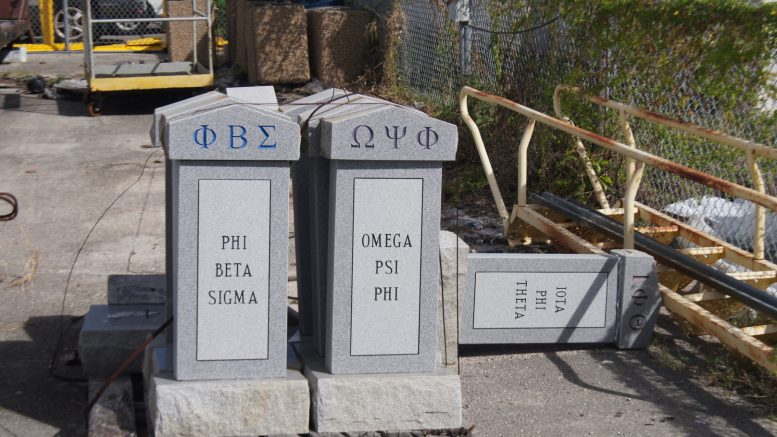The legend of the National Panhellenic Council’s ‘gravestones’ won’t seem to die.
Years ago, the University purchased stones to recognize and commemorate the historically black Greek organizations on campus, and while they’re not actually gravestones per se,according to NPHC leadership, they definitely look like they are.
“They definitely look like tombstones with our organization names and founding dates on top,” said Nathaniel Spencer, member of Phi Beta Sigma fraternity. “Our organizations are here permanently, not here to die, which is how it came across.”

The stones were meant to be plots for the NPHC at FIU. Plots are areas of land or symbols that represent these Greek organizations.
“NPHC constructs symbolically and physically represent each organization’s presence on campus and to give alumni and current members a location for reflection and celebration,” said Phylicia Kirk, president of NPHC in an email to Student Media.
Kirk said that the origin of plots can be traced to the Reconstruction era after the Civil War when former Confederate land was divided into plots for homesteads. As NPHC Greek organizations are historically African-American, the plots serve as a way of remembering their history.
Plots take many different forms across college campuses. At Florida A&M University, NPHC has walls decorated with their organizations letters and designs. At Wake Forest University in North Carolina, they have a circular garden area with plaques for each organization.
In 2015, FIU purchased plots at the request of NPHC, but when they arrived, the students were surprised to see what looked like gravestones with their letters on them.
Jose Toscano, director for Campus Life, said that the stones were purchased using approximately $1,200 gifted by Student Affairs, and the designers did consult with students in NPHC. The finished product just did not meet the original vision of the students.
Toscano told Student Media that after the plots were purchased, no locations was set for their placement on campus, and the NPHC members seemed to “lose steam,” and so the plots went into storage.
The plots currently reside outside of the surplus warehouse on the Modesto Maidique Campus, on the west side of campus near the baseball stadium. They are kept in the open air, some are rusting, and at least one has fallen on the ground.
“If you know anything about our organizations, we respect our letters highly and no one is allowed to wear your letters if they’re not in your organization,” said Spencer. “When we see that our letters are flung and toppled over on the ground, that really hurts and it shows FIU isn’t giving us respect.”

Kirk and her executive board are trying once again to bring plots to campus, and have even come up with ideas for locations where they can be placed.
In her email, Kirk suggested the housing quad, the lake behind the Green Library, and the lake between SIPA and the labor center as spots on MMC, and Panther Square and the lake behind the Wolfe University Center at the Biscayne Bay Campus.
Jefferson Noel, president of the Student Government Council at BBC, told Student Media that he has been in talks with NPHC members about placing plots on BBC, but nothing concrete has been decided yet.
The main issues facing NPHC in this dilemma, according to Toscano, are location and funding.
Even if they find a good place for the plots, Toscano said, the organizations will have to pay for new ones and pay for upkeep, which will take engagement from their alumni and community.
Spencer said this won’t be a problem, as the plots do not have to be expensive as they can just be small plaques or a garden, and they are reaching out to members and former members to raise the initial money. The upkeep and maintenance will just take contributions from NPHC each year, according to him.
As for the tombstones, Kirk and Spencer do not want to use them as the plots, but they may like to get them back from the University for something else. Spencer told Student Media that because the stones have their letters, they should be given to the organizations to do what they will.
Photos by Joshua Ceballos






Be the first to comment on "Greeks want recognition, not gravestones"